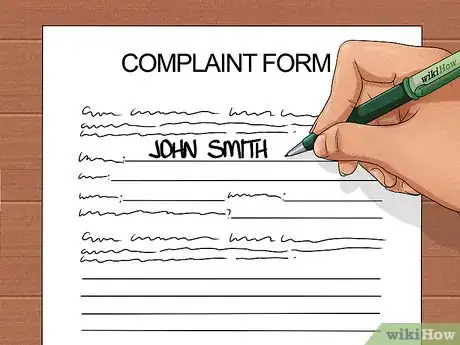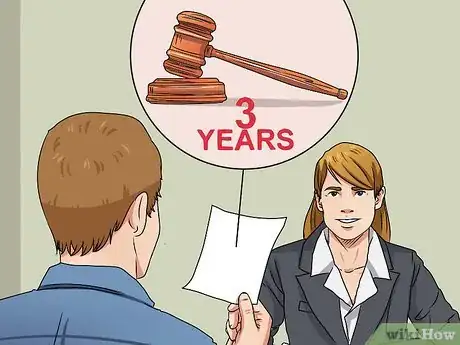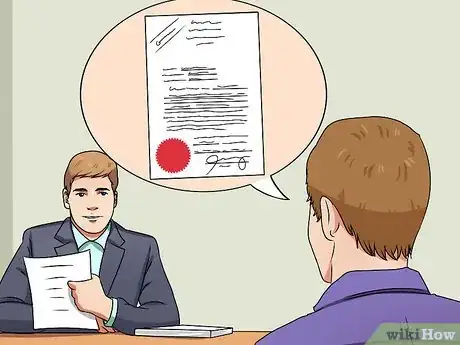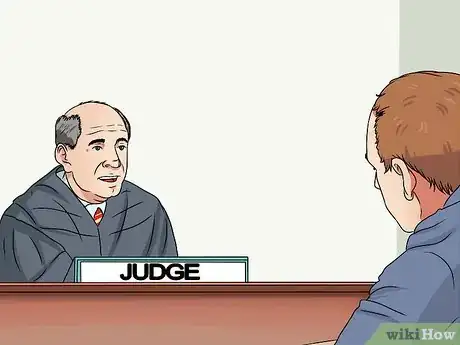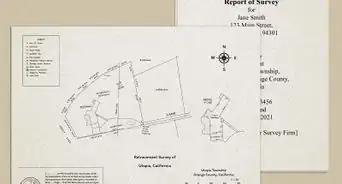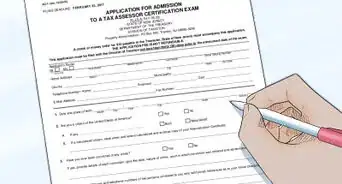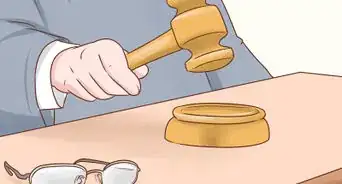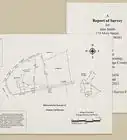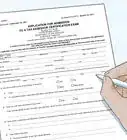This article was co-authored by Jennifer Mueller, JD. Jennifer Mueller is an in-house legal expert at wikiHow. Jennifer reviews, fact-checks, and evaluates wikiHow's legal content to ensure thoroughness and accuracy. She received her JD from Indiana University Maurer School of Law in 2006.
This article has been viewed 131,951 times.
An individual entering the private property of another without permission is trespassing. You can bring charges against trespassers with proof of the incident and proper documentation. A suit for trespass is filed in court, just like any other lawsuit.
Steps
Proving Ownership of the Property
-
1Establish proof of ownership. You must have ownership rights in the property that has been invaded. You may own the property outright, rent it, or lease it. A trespass lawsuit may be brought for trespass to real estate, which is called “real property,” or trespass of personal movable property, which is called “chattels.”
-
2Gather proof of ownership. A copy of your deed, mortgage, lease or rental agreement will satisfy for real estate. For some chattels, like a vehicle, you may also have the title.
- If the chattel is something like a personal laptop computer, then you can prove ownership in other ways. For example, witnesses can testify that they have seen the object in your possession repeatedly.
- Sometimes the chattel may have your identifying features that show that you own it. For example, a laptop may be full of your electronic files.
Advertisement -
3Establish the boundaries of your property. If you are suing for trespass of real property, then you need to know the full extent of the property.
- The deed should have a description of the property. Find your copy of the deed at the county clerk’s office, where deeds are recorded.
- Better yet, you should have the property professionally surveyed, especially if you think trial is unavoidable. Get a copy of your deed and then contact local survey firms, listed in the yellow pages or on the internet.
-
4Ask the trespasser to leave. If you see the trespass occur, you should ask the person to leave. If you witness repeated trespasses but do nothing, a court might infer that you have consented to the trespass.
- Always exercise caution when approaching strangers, and try to have someone with you when you confront a trespasser.
- If you don’t wish to speak to anyone, post “No Trespassing” signs. Make sure they are clearly visible.
Identifying the Trespasser
-
1Document the individual. You will be required to identify the trespassing person. To sue, you need to be able to identify him or her, even if you don't personally know the individual.
- Photographs or a video of the incident will work best to prove your case.
- If relying on memory, write a detailed physical description of the person. Also note any vehicles and license plate numbers.
-
2Document each incident. Keep track of each offense to present to the court. Write down days and time.
- Greater penalties can be sought if the individual has trespassed on your property without permission multiple times, especially if trespassing occurs after you've already filed a civil complaint.
- To bring a suit for trespass to a chattel, the defendant must have substantially interfered with your use of the property. The chattel must have been damaged, or you must have been dispossessed of the property or deprived of its use for a substantial amount time.
- For example, if your sister borrowed your sweater for one hour and returned it undamaged, you would not be able to sue her. But if she “borrowed” your jacket for a substantial amount of time (such as one month), then you could sue her.
-
3Find witnesses. Witnesses can help identify the individual but also testify at trial.
- Ask neighbors who can see your property if anyone has been trespassing on your land. Obtain signed witness statements from these neighbors documenting the dates and times they saw an individual trespassing and descriptions of the trespassing individuals.
-
4Prove property damage. You can be compensated for damage caused by the trespass but you must prove it.
- Take photographs or write detailed descriptions of any property damage that has occurred as a result of trespassing. This documentation can be used as evidence in your lawsuit.
- Have the damage appraised. If someone took your car and wrecked it, then you should get a professional appraisal.
Filing the Lawsuit
-
1Locate the correct court. If you do not sue in the correct court, your lawsuit will be dismissed. Generally, you will file in the court where your property is located.
- Depending on the amount you seek, you may file in Small Claims Court. There is a limit on the amount sought. In Illinois, you cannot seek more than $10,000, including all costs.[1]
- Small Claims Court is designed for you to represent yourself. The rules are typically less formal and you will not need to present legal theories, only the facts.[2]
-
2Prepare a civil complaint and summons. You can request a blank complaint form from your local court. You will need to fill in your name as plaintiff and the trespasser’s name as defendant, then explain what happened and what remedy you seek.
- If the courthouse does not have a blank form, then try to find a blank complaint form on the internet or on a CD of legal forms.
-
3Request injunctive relief. Injunctive relief prohibits future trespassing and allows you to seek police action if it occurs. Injunctive relief can also protect you from expenses due to property damage caused by trespassing.
- Injunctive relief is typically not available in Small Claims Court.[3]
-
4Request compensation for damages suffered. If someone has caused $5,000 worth of damage to your property, then you should also sue for that amount. Do not settle only for injunctive relief.
-
5File quickly. Trespassing complaints carry a statute of limitations, so your complaint may not be considered valid if you wait too long to file.
- Statute of limitations vary by state. In California, the limitations period is 3 years. In Illinois, it is 5 years.[4]
-
6Have the complaint verified. Ask the clerk for stamped copies of the complaint. This will show when you filed it.
-
7File the complaint with the clerk. You will have to pay a filing fee, generally between $100 and $300.
- Be sure to retain three copies.
-
8Serve the defendant. The defendant needs notice of the lawsuit in order to respond. There are different ways to serve the defendant with notice.
- Sometimes you can mail the complaint if you have the trespasser’s home or work address. Check your state’s Rules of Civil Procedure to see if you can serve notice by mail.
- Generally, you should have the complaint personally served. You may use either the County Sheriff or a private process server. Each service will cost around $100.
Getting Compensated
-
1Stay open to settlement or mediation. A defendant may honestly not know that he has damaged your property and could offer to settle out of court. If your attorney is expensive or you are not sure of winning the case, then settlement might be right for you.
- Alternate dispute resolution, such as mediation, is also an option. Your local court may run a mediation program. Be sure to stop in and ask.
-
2Read the defendant’s answer. If the defendant is unwilling to settle, he must answer your complaint. Most likely, he will allege that he wasn’t the one who trespassed or he will argue that he didn’t damage your property.
-
3Attend pretrial hearings. If you do not have an attorney, then you will need to attend all pretrial hearings because you are representing yourself. You should listen carefully to any dates and what documents the court needs from you.
- If you fail to file necessary documents by the appointed time, then the defendant can move to have the case dismissed.
-
4Prepare for trial. If a court case is unavoidable, then prepare for it in the same manner as any other case. Gather your evidence, notify witnesses, and be confident.
- You will need documentation of damage and trespass as exhibits to use at trial. Fortunately, you compiled this information before filing the complaint.
- Issue a summons to each witness. The summons lists the day and time, as well as the location, of the trial. A summons must be mailed to or personally served on each witness.
-
5Participate in trial. If you have an attorney, she will do most of the work at trial: deliver an opening statement, examine witnesses, and make a final summation.
- An attorney is recommended unless you are in Small Claims Court. The amount of money at stake makes an attorney worthwhile.
- In Small Claims Court, you may get five minutes to explain the facts of your case.[5] Practice explaining your case to friends or relatives so that you can speak effectively and efficiently in front of the judge, without stumbling.
-
6Collect judgment. If you win money damages, you should vigorously pursue the defendant for payment. If the defendant refuses to pay, then you should ask the Court for paperwork to start garnishment of wages.
References
- ↑ http://www.ag.state.il.us/consumers/smlclaims.html
- ↑ http://www.nolo.com/legal-encyclopedia/free-books/small-claims-book.html
- ↑ http://www.equinelegalsolutions.com/smallclaimsprosandcons.html
- ↑ http://research.lawyers.com/illinois/illinois-statutes-of-limitations.html
- ↑ http://www.nolo.com/legal-encyclopedia/free-books/small-claims-book.html
About This Article
If a person enters your private property without permission, you can sue them for trespassing. To bring charges, you have to own, rent, or lease the property and be able to identify the trespasser through photographs or a video of the incident. If you’re relying on memory, write a detailed description of the person. When you’re ready to file your lawsuit, request a blank complaint form from your local court. Request an injunction relief too, which prohibits future trespassing and lets you seek police action if it occurs. When you’re done filling out the paperwork, file the complaint with the clerk and pay the filing fee, which is typically between 100 and 300 dollars. To learn how to prepare for trials, keep reading!









